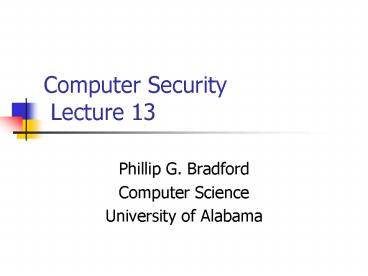Computer Security Lecture 13 PowerPoint PPT Presentation
1 / 21
Title: Computer Security Lecture 13
1
Computer Security Lecture 13
- Phillip G. Bradford
- Computer Science
- University of Alabama
2
Lecture Outline
- Review Last Lecture
- Feistel Ciphers
- TEA (Tiny Encryption Algorithm)
3
Objectives
- Work with Feistel Networks
- Understand their mechanics
- Understand their importance
- Understand a small Feistel Network Based Cipher
TEA - Cryptanalysis of TEA
4
Feistel Networks
- Design Structure of Many Important Symmetric
Ciphers - At ith step
- Left side Li
- Right side Ri
- Li Ri-1
- Ri Li-1 xor f(Ri-1,ki)
- Or just say Ri Li-1 xor fi(Ri-1)
5
Feistel Networks
- Important Property from XOR
- Li-1 xor fi(Ri-1) xor fi(Ri-1) Li-1
- If G(f1, f2, , ft) is a Feistel Network
- Then G-1(f1, f2, , ft) G(ft, ft-1, , f1)
- Why is this property important?
- The functions may even be one-way
- Hardware decryption
6
Feistel Ciphers
Plain Text 2n bits
n high bits
n low bits
F
Key
XOR
Swap Sides
F
Key
XOR
Swap Sides
7
TEATiny Encryption Algorithm
- By David Wheeler and Roger Needham
- See http//vader.brad.ac.uk/tea/tea.shtml
- D. Wheeler and R. Needham, TEA, a Tiny
Encryption Algorithm, Fast Software Encryption,
Second International Workshop Proceedings,
Springer-Verlag, 97110, 1995.
8
TEA is a Feistel Network
- Assumes 32-bit words (calcs mod 232)
- Key k0,,k3 a total of 128 bits
- Authors mention, 6 cycles may be sufficient for
OK security - The value delta sqrt(5) -1231
- Recall a gtgt b is the same as a/2b
- And a ltlt b is a2b
9
Encryption with TEA http//vader.brad.ac.uk/tea/t
ea.shtml
- yv0, zv1, sum0, delta0x9E3779B9, ak0,
bk1, ck2, dk3, n32 - while(n--gt0)
- sum delta
- y (z ltlt 4)a zsum (z gtgt 5)b
- z (y ltlt 4)c ysum (y gtgt 5)d
- w0y w1z
10
TEA
- Uses addition/subtraction in place of xor
- For combining sides
- Plaintext L0R0
- yz
- Encryption
- Li Ri-1
- Ri Li-1 fi(Ri-1)
- The fis are distinguished by sum
11
TEA
- More precisely
- All calcs are mod 232
- fi(Ri-1)
- ((z ltlt 4)a
- xor ((z gtgt 5)b
- xor z sum
12
TEA
- Decryption
- Ri Li-1
- Li Ri-1 - fi(Li-1)
- The fis are distinguished by sum
13
Decryption with TEA http//vader.brad.ac.uk/tea/t
ea.shtml
- yv0, zv1, sum0xC6EF3720, delta0x9E3779B9,
ak0, bk1, ck2, dk3, n32 - / sum deltaltlt5, in general sum delta n /
- while(n--gt0)
- z - (y ltlt 4)c ysum (y gtgt 5)d
- y - (z ltlt 4)a zsum (z gtgt 5)b
- sum - delta
- w0y w1z
14
How Good is TEA?
- How big is the key space?
- There can be 2128 keys k0, , k3
- How many are equivalent?
- If they were all distinct in that for any message
m, TEAk1m TEAk2m iff k1 k2 - Then is running 2128 TEA decryptions infeasible?
- Do we have computational security?
15
How Good is TEA?
- Well, 2128 is about 3.4 x 1038
- Looking at the Motorola 680x0 Assembly versions
of TEA on line are - About 32 instructions run in 16 rounds
- Or 29 or 512 or about 5 x 102 instructions
- Say we can process 1 Gig instructions per second
109 instructions/sec
16
How Good is TEA?
- This means, we can run about
- 2 x 106 or 2 million instantiations of the TEA
decryption algorithm every second - But, if all keys are distinct, then in the worst
case we must run - 3.4 x 1038 / 2 x 106
- About 1.7 x 1032 seconds
17
How Good is TEA?
- There are about
- 606024365 3.2 x 107 seconds in a year
- Thus, we need 1.7 x 1032 / 3.2 x 107
- Or about 5 x 1024 years for a worst case
exhaustive search! - I think it is fair to say, if only restricted to
this attack all keys are distinct, - Then TEA is computationally secure
18
Examining our Assumptions
- Key assumption 2128 distinct keys
- In fact, this is false !
- We will follow Mirzas paper and show that the
key space is of size 2126 - Well, not a great improvement, but something
19
Examining our Assumptions
- TEA is implemented in 32-bit words
- All computation is mod 232
- So, 231 231 0
- Now, it is claimed that
- X Y (X xor 231) (Y xor 231)
- In cases
- If X 231 and Y 231, then holds
- If X 231 and Y lt 231, then holds, symmetric
case - If X lt 231 and Y lt 231, then holds
20
Examining our Assumptions
- fi(Ri-1)
- ((z ltlt 4)a
- xor ((z gtgt 5)b
- xor z sum
- ((z ltlt 4)(a xor 231)
- xor ((z gtgt 5)(b xor 231)
- xor z sum
21
To Be Continued!
- Friday

